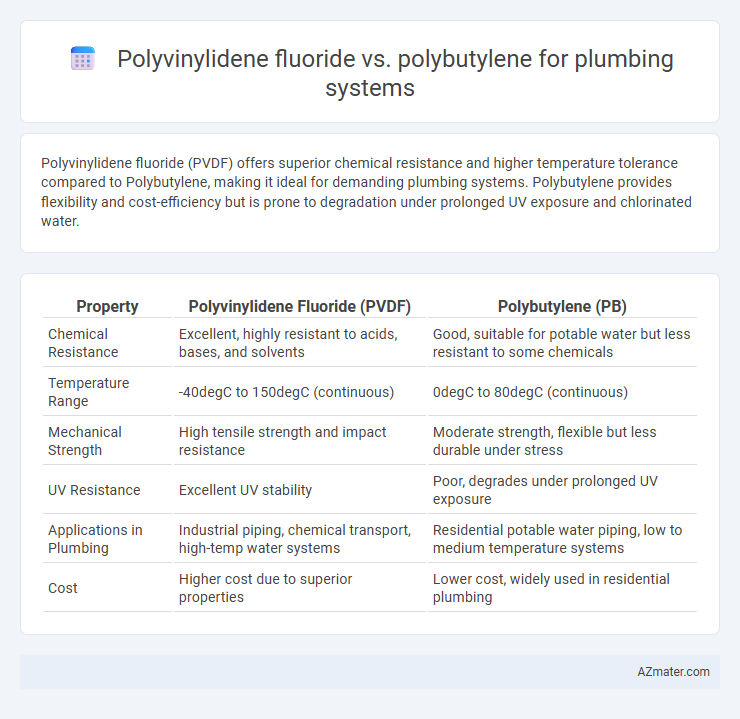Polyvinylidene fluoride (PVDF) offers superior chemical resistance and higher temperature tolerance compared to Polybutylene, making it ideal for demanding plumbing systems. Polybutylene provides flexibility and cost-efficiency but is prone to degradation under prolonged UV exposure and chlorinated water.
Table of Comparison
| Property | Polyvinylidene Fluoride (PVDF) | Polybutylene (PB) |
|---|---|---|
| Chemical Resistance | Excellent, highly resistant to acids, bases, and solvents | Good, suitable for potable water but less resistant to some chemicals |
| Temperature Range | -40degC to 150degC (continuous) | 0degC to 80degC (continuous) |
| Mechanical Strength | High tensile strength and impact resistance | Moderate strength, flexible but less durable under stress |
| UV Resistance | Excellent UV stability | Poor, degrades under prolonged UV exposure |
| Applications in Plumbing | Industrial piping, chemical transport, high-temp water systems | Residential potable water piping, low to medium temperature systems |
| Cost | Higher cost due to superior properties | Lower cost, widely used in residential plumbing |
Introduction to Polyvinylidene Fluoride (PVDF) and Polybutylene (PB)
Polyvinylidene fluoride (PVDF) is a highly non-reactive and pure thermoplastic fluoropolymer known for its excellent chemical resistance, high thermal stability, and durability in demanding plumbing applications. Polybutylene (PB) is a flexible, lightweight polymer widely used in plumbing due to its ease of installation, resistance to scale buildup, and moderate chemical resistance. Both materials serve distinct roles in plumbing systems, with PVDF favored for high-performance environments and PB commonly used in residential water distribution.
Chemical Composition and Structure: PVDF vs PB
Polyvinylidene fluoride (PVDF) is a semi-crystalline fluoropolymer composed primarily of repeating units of vinylidene fluoride, characterized by strong carbon-fluorine bonds providing exceptional chemical resistance and thermal stability. Polybutylene (PB), a polyolefin made of repeating butylene monomers, exhibits a flexible carbon-carbon backbone with less resistance to chemical degradation but offers superior impact strength and flexibility. The fluorinated structure of PVDF makes it highly resistant to harsh chemicals and UV exposure, whereas PB's hydrocarbon backbone is more susceptible to oxidation and chemical attack but remains cost-effective and easier to process for plumbing applications.
Durability and Lifespan Comparison
Polyvinylidene fluoride (PVDF) offers superior chemical resistance and UV stability compared to Polybutylene (PB), making it highly durable in various plumbing environments. PVDF's lifespan can exceed 50 years under normal operating conditions, whereas Polybutylene typically lasts around 20-30 years before degradation or failure occurs. The enhanced mechanical strength and resistance to thermal degradation in PVDF contribute to its longer-lasting performance in plumbing systems.
Corrosion and Chemical Resistance in Plumbing
Polyvinylidene fluoride (PVDF) offers superior corrosion resistance compared to Polybutylene (PB), making it highly suitable for harsh chemical environments in plumbing systems. PVDF exhibits excellent chemical resistance to acids, bases, and organic solvents, ensuring long-term durability and minimal degradation. In contrast, Polybutylene is more susceptible to chemical attack and oxidation, which can reduce its lifespan and compromise system integrity.
Temperature and Pressure Performance
Polyvinylidene fluoride (PVDF) outperforms Polybutylene (PB) in plumbing applications due to its superior temperature and pressure resistance, with PVDF sustaining continuous temperatures up to 150degC and pressures exceeding 20 MPa. Polybutylene typically operates safely at lower temperatures around 60degC and pressures near 10 MPa, limiting its use in high-demand environments. The chemical inertness and high mechanical strength of PVDF make it preferable for systems requiring durability under thermal stress and elevated pressure conditions.
Installation Methods and Ease of Use
Polyvinylidene fluoride (PVDF) plumbing systems typically require fusion welding, solvent cementing, or mechanical fittings for installation, offering excellent chemical resistance and durability but demanding specialized skills and equipment. Polybutylene pipes utilize push-fit or crimping methods, allowing faster and easier installation with standard plumbing tools, though they are less resistant to chemical degradation compared to PVDF. The ease of use in polybutylene systems makes them preferred for residential applications, while PVDF is favored in industrial settings where installation complexity is offset by superior performance.
Cost Analysis: PVDF vs Polybutylene
Polyvinylidene fluoride (PVDF) generally incurs higher upfront costs compared to Polybutylene due to its superior chemical resistance, thermal stability, and durability in plumbing systems. Despite the initial price difference, PVDF's extended lifespan and lower maintenance requirements can reduce total lifecycle expenses significantly. In contrast, Polybutylene offers a more affordable initial investment but may involve higher long-term costs related to repairs, failures, and replacement due to its susceptibility to cracking and degradation under certain conditions.
Safety and Health Considerations
Polyvinylidene fluoride (PVDF) offers superior chemical resistance and high thermal stability, ensuring minimal leaching of harmful substances into potable water, which enhances safety in plumbing systems. Polybutylene (PB), while flexible and cost-effective, has shown vulnerability to oxidative degradation, potentially leading to leaks and water contamination that pose health risks. Choosing PVDF over PB significantly reduces the likelihood of chemical contamination and pipe failure, promoting safer water quality and long-term health protection.
Common Applications in Modern Plumbing
Polyvinylidene fluoride (PVDF) is widely used in plumbing systems for chemical-resistant piping, particularly in industrial and high-purity water applications, due to its exceptional resistance to acids, bases, and solvents. Polybutylene (PB) pipes, once popular for residential water supply systems, offer flexibility and ease of installation but have declined in use because of susceptibility to oxidative damage and failure over time. Modern plumbing favors PVDF in demanding environments requiring high-performance durability, while polybutylene is primarily found in legacy plumbing installations.
Conclusion: Choosing the Right Material for Your Plumbing System
Polyvinylidene fluoride (PVDF) offers superior chemical resistance, high-temperature tolerance, and durability, making it ideal for aggressive fluid applications in plumbing systems. Polybutylene (PB) is more flexible and cost-effective, suitable for residential water supply but less resistant to heat and chemicals. Selecting the right material depends on specific system requirements like fluid type, temperature, pressure, and budget constraints to ensure long-term performance and safety.

Infographic: Polyvinylidene fluoride vs Polybutylene for Plumbing system
 azmater.com
azmater.com